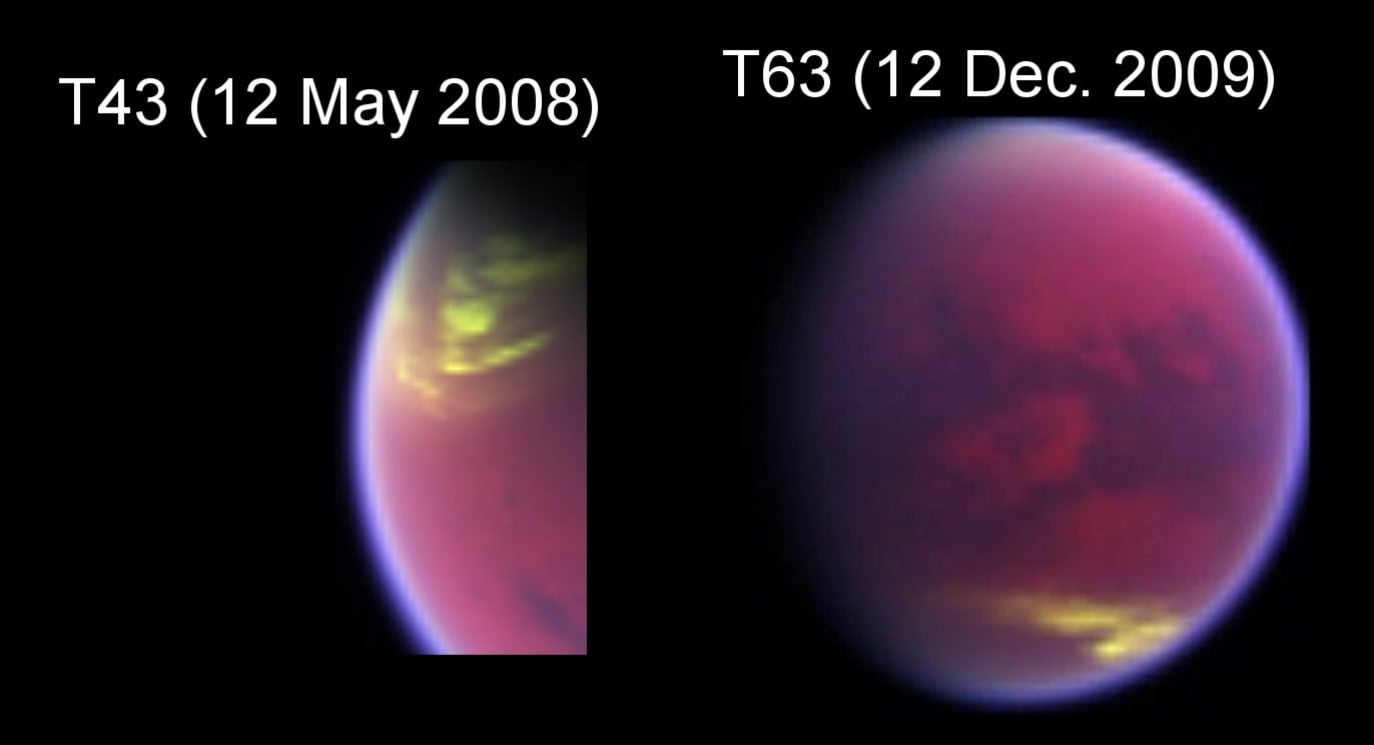[/caption]
The beauty of an extended space mission is that scientists can make long term observations and find out things we've never known before. The Cassini spacecraft's Visual and Infrared Mapping Spectrometer (VIMS) instrument has been monitoring clouds on Titan continuously since the spacecraft went into orbit around Saturn in 2004, and a team led by Sébastien Rodriguez (AIM laboratory - Université Paris Diderot) has used more than 2,000 VIMS images to create the first long-term study of Titan's weather. Are they ready to make a weather forecast? They say Titan's northern hemisphere is set for mainly fine spring weather, with polar skies clearing since the equinox in August last year.
Together with Saturn in its 30-years orbit around the Sun, Titan has seasons that last for 7 terrestrial years. The team has observed significant atmospheric changes between July 2004 (early summer in the southern hemisphere) and April 2010, the very start of northern spring. The images showed that cloud activity has recently decreased near both of Titan's poles. These regions had been heavily overcast during the late southern summer until 2008, a few months before the equinox.
"Over the past six years, we've found that clouds appear clustered in three distinct latitude regions of Titan: large clouds at the north pole, patchy cloud at the south pole and a narrow belt around 40 degrees south. However, we are now seeing evidence of a seasonal circulation turnover on Titan – the clouds at the south pole completely disappeared just before the equinox and the clouds in the north are thinning out. This agrees with predictions from models and we are expecting to see cloud activity reverse from one hemisphere to another in the coming decade as southern winter approaches," said Dr Rodriguez.
[caption id="attachment_74183" align="aligncenter" width="580" caption="Fractional cloud coverage in Titan's atmosphere integrated between July 2004 and April 2010. Black areas are cloud free and yellow are fully covered. Credit: NASA/JPL/University of Arizona/University of Nantes/ University of Paris Diderot "]
[/caption]
The team has used results from the Global Climate Models (GCMs) developed by Pascal Rannou (Institut Pierre Simon Laplace) to interpret the evolution of the observed cloud patterns over time. Northern polar clouds of ethane form in the Titan's troposphere during the winter at altitudes of 30-50 km by a constant influx of ethane and aerosols from the stratosphere. In the other hemisphere, mid- and high-latitudes clouds are produced by the upwelling from the surface of air enriched in methane. Observations of the location and activity of Titan's clouds over long periods are vital in developing a global understanding of Titan's climate and meteorological cycle.
In Feburary 2010, the Cassini mission was extended to a few months past Saturn's northern summer solstice in May 2017. This means that Rodriguez and his team will be able to observe the seasonal changes right the way through from mid-winter to mid-summer in the northern hemisphere.
"We have learned a lot about Titan's climate since Cassini arrived in at Saturn but there is still a great deal to learn. With the new mission extension, we will have the opportunity to answer some of the key questions about the meteorology of this fascinating moon," said Rodriguez.
Rodriguez presented the results at the European Planetary Science Congress 2010 in Rome.
Source:
European Planetary Science Conference
 Universe Today
Universe Today
